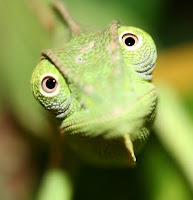Jurriaan de Groot of the University of Leiden, and Johan van Leeuwen of the University of Wageningen, take X-ray high-speed film, which is 500 frames per second, to investigate how the chameleon tongue works when catching prey. These films showed that the tip of the chameleon's tongue accelerated at 50 g (g = gravitational constant). Acceleration is five times greater than can be achieved by a jet fighter.
Textbooks zoologist explained that the ballistic tongue chameleon is reinforced by a piece of muscle accelerator (accelerator). This muscle extends when pressing down on the tongue bone, which is a stiff cartilage in the middle of the tongue, which wrapped. However, in a study that has been approved for publication by the scientific journal Proceedings of the Royal Society of London (Series B), two experts who studied the morphology of the eating habits of the chameleon discovered other elements associated with the rapid movement of the animals tongue.
The researchers dissected the tongue tissues and discovered that the accelerator muscle is not strong enough to generate the necessary force alone. Gan Den Examining chameleon tongues, they discovered the presence of at least 10 packs of slippery, hitherto unknown, between the accelerator muscle and the tongue bone.
These sheaths, attached to the tongue bone at the end closest to the mouth, fiber protein observed spiral wound. The fibers are compressed and deformed when the accelerator muscle contracts and store energy like a rubber band.
This catapult has another very striking characteristics. The tip of the tongue taking a hollow shape when attacking prey. When ejected, the tongue may protrude as far as six times the length when a break in the mouth, and twice the length of its own body.
When the bone reaches the tip of the tongue round, sheats rigorous and extends simultaneously sliding and shrink with force and propel the tongue. As soon fibers slide from the tongue bone, the sheaths separate from one another like the tubes of a telescope, and the tongue thus attains maximum stretch. Van Leeuwen said, "This is a telescopic catapult."
Muscle groups with different properties impeccably cast tongue, speed, causing the tongue to assume a sucker form when it strikes its prey and then quickly withdraw it.
Muscle group is by no means mutually blocking the function of each, but the space for works by Gan synchronized prey punching and pulling the tongue back into the mouth in less than one second. Plus, thanks to the cooperation between the visual system and brain, measured prey positions and orders for ballistic tongue to "fire!" Given by nerves that transmit signals in the brain.


Tidak ada komentar:
Posting Komentar